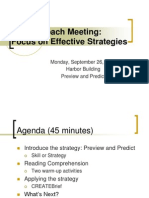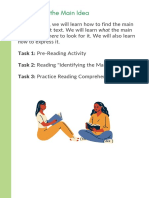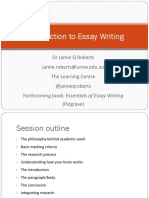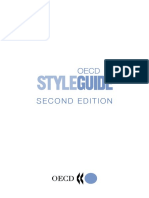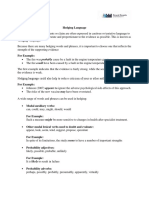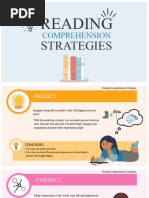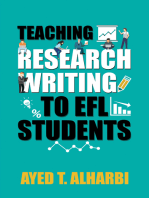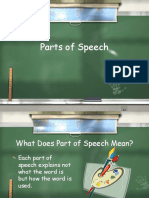Strategies For Teaching Text Structure
Uploaded by
Zalina Binti KematStrategies For Teaching Text Structure
Uploaded by
Zalina Binti Kemat20 Strategies to Teach Text Structure
As early as third grade, students are expected to recognize expository text structures such as the following: sequence, description, compare-contrast, cause-effect, and problem-solution. The ability to identify and analyze these text structures in reading helps make expository text easier to understand. Students should also use these text structures to organize their own writing. The following research-based teaching strategies can be applied in teaching students to use text structure:
1. Discuss with students that writers use text structures to organize information. Introduce the concept to them, and reinforce it every time students read and write. 2. Introduce and work on text structures in this order: description, sequence, problem and solution, cause and effect, and compare and contrast. 3. Skim and scan to predict text structure(s). Make predicting possible text structures a part of every pre-reading activity. 4. Teach the signal words for each text structure. Prior to reading, skim and scan passages and make predictions about text structure. During reading, analyze text and revise predictions about structure. 5. Teach and model the use of graphic organizers to go with each text structure. Identify text structures in advance and provide appropriate advanced organizer. For example, the teacher models charting the structure of specific paragraphs while reading and also provides practice in using the graphic organizer to write different text types. 6. Scaffold instruction using the gradual release of responsibility model. Spend quality instructional time in each phase of the model when teaching text structure strategies. For example, the teacher uses a think aloud to model for demonstration. The teacher then invites students to participate for shared demonstration. Then students practice with teacher support for guided practice. Finally, students apply the skills and strategies they have learned for independent practice. 7. Provide explicit instruction. For example, the teacher shows students specifically how and when to use strategies such as attending to signal words while reading different content areas or using signal words when writing expository text. 8. Model a think-aloud strategy. The teacher reads aloud a paragraph, pausing at appropriate points to share her own comprehension strategies and understanding of the text. Next the teacher might move to a shared-reading strategy, encouraged students to talk aloud as they engage in the process with the teacher. For example, the teacher asks students to talk about the clues they use to try to identify the text structure. 9. Ask focusing questions targeting text structure. Teachers can use focusing questions as a means of scaffolding the use of strategies or assisting students in the think-aloud process. For example, the teacher asks a student which signal word might be best to show a particular relationship among ideas in a text structure. 10. Use and create non-linguistic representations. For example, during reading the teacher models the drawing of a series of pictures to represent a sequence described in the passage. Shared by: Kristi Orcutt, Reading & Writing Consultant, kristio@essdack.org
20 Strategies to Teach Text Structure
11. Create and provide pattern guides and teacher-made organizers that reflect that structure of the original text. These tools help students focus on the key elements of the reading selection. 12. Present students with a completed graphic organizer as a pre-reading strategy. Have students write a probable paragraph using a predicted text structure prior to reading. After reading, compare students probable passages and the original text. 13. Write using the text structures. While students watch, the teacher models writing a paragraph using a particular text structure and describes her actions as she is writing. Then students write their own paragraphs using text structure/ paragraph frames as templates. 14. Make the connection between reading and writing. When students read an example of a particular text structure, have them write using that same text structure. Writing can be done as a pre-reading or post-reading strategy. 15. Rewrite a paragraph or passage using a different text structure than the original. Compare the two and analyze why the author might have chosen the original pattern. 16. Read and analyze a variety of text, both single-structure passages and multistructure passages. Use every opportunity that students read as an opportunity to teach text structure. 17. Have a text structure treasure hunt with a newspaper, classroom magazine, nonfiction book, textbook chapter, or students independent reading material. 18. Use summary frame questions to guide students comprehension before, during, and after reading. Each organizational structure suggests questions which readers should consider as they are reading and be able to answer once they've finished reading the passage. 19. Use text coding strategies highlighters, Post-It Notes, etc. targeting text structures. Remember to model these strategies in advance and be consistent in your procedures (same color each time, etc.). For additional coding ideas, visit the Text Mapping site: http://www.textmapping.org/overview.html 20. Use text structure sorts to compare different paragraphs on a single topic. Begin by analyzing and sorting only one text structure at a time, then add another and so on. Remember: Identifying patterns of organization is NOT the ultimate goal of text structure teaching. This ability is only beneficial as students internalize knowledge about text structure and subsequently use it to enhance their comprehension. Teach students to use text structures to improve their reading comprehension and writing organization. Shared by: Kristi Orcutt, Reading & Writing Consultant, kristio@essdack.org
You might also like
- Hourglass Workout Program by Luisagiuliet 276% (21)Hourglass Workout Program by Luisagiuliet 251 pages
- The Hold Me Tight Workbook - Dr. Sue Johnson100% (16)The Hold Me Tight Workbook - Dr. Sue Johnson187 pages
- Read People Like A Book by Patrick King-Edited62% (65)Read People Like A Book by Patrick King-Edited12 pages
- Livingood, Blake - Livingood Daily Your 21-Day Guide To Experience Real Health77% (13)Livingood, Blake - Livingood Daily Your 21-Day Guide To Experience Real Health260 pages
- COSMIC CONSCIOUSNESS OF HUMANITY - PROBLEMS OF NEW COSMOGONY (V.P.Kaznacheev,. Л. V. Trofimov.)94% (212)COSMIC CONSCIOUSNESS OF HUMANITY - PROBLEMS OF NEW COSMOGONY (V.P.Kaznacheev,. Л. V. Trofimov.)212 pages
- Donald Trump & Jeffrey Epstein Rape Lawsuit and Affidavits83% (1016)Donald Trump & Jeffrey Epstein Rape Lawsuit and Affidavits13 pages
- The 36 Questions That Lead To Love - The New York Times94% (34)The 36 Questions That Lead To Love - The New York Times3 pages
- The 36 Questions That Lead To Love - The New York Times95% (21)The 36 Questions That Lead To Love - The New York Times3 pages
- Jeffrey Epstein39s Little Black Book Unredacted PDF75% (12)Jeffrey Epstein39s Little Black Book Unredacted PDF95 pages
- The 4 Hour Workweek, Expanded and Updated by Timothy Ferriss - Excerpt23% (954)The 4 Hour Workweek, Expanded and Updated by Timothy Ferriss - Excerpt38 pages
- How To Teach Expository Text Structure To Facilitate Reading ComprehensionNo ratings yetHow To Teach Expository Text Structure To Facilitate Reading Comprehension4 pages
- Reading Strategies: by Laurie Rozakis, PH.D0% (1)Reading Strategies: by Laurie Rozakis, PH.D33 pages
- Course Outline - English Reading Writing 1 - Anh116dl02No ratings yetCourse Outline - English Reading Writing 1 - Anh116dl029 pages
- Applying Current Approaches To The Teaching of ReadingNo ratings yetApplying Current Approaches To The Teaching of Reading8 pages
- Introduction To Essay Writing - by DR Jamie Roberts (Author of Essentials of Essay Writing)100% (1)Introduction To Essay Writing - by DR Jamie Roberts (Author of Essentials of Essay Writing)120 pages
- Resource Book For Efl Teachers in Central Asia Classrules-Activities-GamesNo ratings yetResource Book For Efl Teachers in Central Asia Classrules-Activities-Games452 pages
- 3 R Eceptive Skills: Reading: How Can You Help Your Students Improve Their Reading?No ratings yet3 R Eceptive Skills: Reading: How Can You Help Your Students Improve Their Reading?5 pages
- Critical Reflection: Who Am I As A Learner? EDFD546 Tyler-Shaye Miller S00271438No ratings yetCritical Reflection: Who Am I As A Learner? EDFD546 Tyler-Shaye Miller S0027143821 pages
- Ten Steps To Effective Listening: Taking Notes Analyzing and Synthesizing What Is Read Figurative LanguageNo ratings yetTen Steps To Effective Listening: Taking Notes Analyzing and Synthesizing What Is Read Figurative Language4 pages
- Dokumen - Tips - Argumentative Essay 55888caed8616No ratings yetDokumen - Tips - Argumentative Essay 55888caed861618 pages
- Prefixes and Suffixes - Advanced EnglishNo ratings yetPrefixes and Suffixes - Advanced English8 pages
- Lesson Plan: Business/Materials Lesson ObjectivesNo ratings yetLesson Plan: Business/Materials Lesson Objectives2 pages
- 011 - Module 8 - How To Teach VocabularyNo ratings yet011 - Module 8 - How To Teach Vocabulary12 pages
- Types of Conjunctions: "Conjunction Used To Join Two Words / Sentences"No ratings yetTypes of Conjunctions: "Conjunction Used To Join Two Words / Sentences"16 pages
- Read The Text and Answer The Questions English Academic Writing: The "A" PaperNo ratings yetRead The Text and Answer The Questions English Academic Writing: The "A" Paper2 pages
- Colorful Illustrative Reading Comprehension Strategies Presentation - 20240221 - 075001 - 0000100% (1)Colorful Illustrative Reading Comprehension Strategies Presentation - 20240221 - 075001 - 000010 pages
- Lesson 2: Part A - Reading: Guessing Word Meaning Using Word Prefixes & RootsNo ratings yetLesson 2: Part A - Reading: Guessing Word Meaning Using Word Prefixes & Roots8 pages
- Presentation Techniques and Introductory Activities100% (3)Presentation Techniques and Introductory Activities19 pages
- Reading and Comprehension in the African Context: A Cognitive EnquiryFrom EverandReading and Comprehension in the African Context: A Cognitive EnquiryNo ratings yet
- Preston Lee’s 2-in-1 Book Series! Beginner English & Conversation English Lesson 1: 20 For Arabic SpeakersFrom EverandPreston Lee’s 2-in-1 Book Series! Beginner English & Conversation English Lesson 1: 20 For Arabic SpeakersNo ratings yet
- English Language, Literature and Creative Writing: A Practical Guide for StudentsFrom EverandEnglish Language, Literature and Creative Writing: A Practical Guide for StudentsNo ratings yet
- WORKBOOK HPE1013 Students Copy Fourth EdNo ratings yetWORKBOOK HPE1013 Students Copy Fourth Ed86 pages
- A5 Size WORKBOOK HPE1013 Students Copy Fourth EdNo ratings yetA5 Size WORKBOOK HPE1013 Students Copy Fourth Ed107 pages
- Critical Reading: Identifying Main Ideas, Topic Sentences, Supporting DetailsNo ratings yetCritical Reading: Identifying Main Ideas, Topic Sentences, Supporting Details11 pages
- Contextual Reference: Reference Words/ Transitional MarkersNo ratings yetContextual Reference: Reference Words/ Transitional Markers50 pages
- Enhancement Class/ Revision For Final: Instructions To CandidatesNo ratings yetEnhancement Class/ Revision For Final: Instructions To Candidates13 pages
- Medieval English Surnames Resource Sample PDFNo ratings yetMedieval English Surnames Resource Sample PDF6 pages
- Danica Duval Assignment 1contemporary Teacher LearningNo ratings yetDanica Duval Assignment 1contemporary Teacher Learning69 pages
- Using Technology To Support Effective Mathematics TeachingNo ratings yetUsing Technology To Support Effective Mathematics Teaching3 pages
- Sustainability Report Unimap - Mission Vision EtcNo ratings yetSustainability Report Unimap - Mission Vision Etc2 pages
































